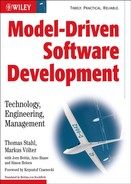Foreword
Modeling is a key tool in engineering. Engineers routinely create models when analyzing and designing complex systems. Models are abstractions of a system and its environment. They allow engineers to address their concerns about the system effectively, such as answering particular questions or devising required design changes. Every model is created for a purpose. A particular model may be appropriate for answering a specific class of questions, where the answers to those questions will be the same for the model as for the actual system, but it may not be appropriate for answering another class of questions. Models are also cheaper to build than the real system. For example, civil engineers create static and dynamic structural models of bridges to check structural safety, since modeling is certainly cheaper and more effective than building real bridges to see under what scenarios they will collapse.
Models are not new in software development. Over the past few decades, the software industry has seen numerous analysis and design methods, each with its own modeling approaches and notations. More recently, we have witnessed the remarkable progress of Unified Modeling Language (UML), which now has a larger market penetration than any single previous modeling notation. Still, analysis and design models rarely enjoy the same status as code. The reality of most software projects is that models are not kept up-to-date with the code, and therefore they become obsolete and useless with time.
Model-Driven Software Development (MDSD) puts analysis and design models on par with code. Better integration of such models and code should significantly increase the opportunity to effect change through the models, rather than simply modifying the code directly. MDSD encompasses many different techniques across the entire spectrum of software development activities, including model-driven requirements engineering, model-driven design, code generation from models, model-driven testing, model-driven software evolution, and more.
The Model-Driven Architecture (MDA) initiative by the Object Management Group (OMG) has also certainly contributed a great deal to the recent surge of interest in software modeling and model-driven techniques. But the effects of that initiative have been both good and bad. On the positive side, I’m glad that modeling has been moved into the center of interest and that organizations are now trying to figure out how their current practices can be leveraged through model-driven techniques. At the same time, the marketing hype around MDA has tended to create some unrealistic expectations. Putting all this hype aside, I do think that MDSD has great ideas to offer, many of which can be put to work in practical situations today. Realizing these potentials requires a solid understanding of current MDSD technology, its applicability, and its limitations.
The authors of this book are at the forefront of MDSD research and practice. Markus and Jorn have organized and participated in a series of MDSD workshops at several OOPSLA conferences. Simon has participated in OMG’s standardization efforts on model transformation. All the authors are pioneering this technology in practice in several domains, ranging from enterprise applications to embedded software in both small and large organizations, such as b+m, Siemens, and BMW.
I’m very pleased to introduce this book to you. In my view, this is one of the rare books in the model-driven space that talks not only about the vision, but also about what is possible today, and how to do it. After a minimal but necessary dose of basic concepts and terminology, the authors cover a wide range of MDSD technology topics such as metamodeling, component architectures and composition, code generation, model transformation, MDA standards, and MDSD tools. I particularly like the hands-on approach that the authors have taken. They illustrate available tools and techniques through concrete modeling examples and code snippets, and they give numerous practical tips and ‘mind-the-gap’ hints. In addition to the technology topics, the authors also present a comprehensive treatment of essential software engineering aspects such as testing, versioning, process management, and adoption strategies, as they apply to MDSD. The content is topped off with two case studies, that were inspired by realistic applications from the authors’ collective experiences.
The authors present a broad perspective of MDSD that goes beyond MDA to cover a range of related approaches including software product lines, domain-specific languages, software factories, and aspect-oriented and generative programming. As in any young, dynamic, and still evolving field, the abundance of competing ideas, concepts, and parallel terminologies in today’s model-driven space can be bewildering. As a result, the authors had to do a lot of ‘sifting through the mud’ to give us a clear and balanced picture of the entire model-driven field. In this book, they have done just that, tremendously well.
I invite you to explore this new and exciting field, and this book is a great place to start!
Krzysztof Czarnecki
Waterloo, January 2006
